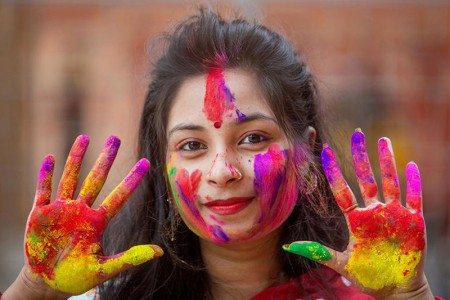Holi marks the end of winter
Observed by millions around the world, the religious event [pronounced like "holy"] celebrates new life and the victory of good over evil. It usually takes place over two days, and it's on 8 March in 2023.
It's best known for its bright colours
People gather in crowds to pelt each other with perfumed, coloured powder called gulal. They'll also use water pistols and water balloons to make the powder stick.
Each colour has a special meaning
There's no one sure story behind the colour-throwing. The god Krishna is sometimes said to have thrown coloured water at people when he was a boy, for example. He's represented by blue powder, while red is for love and yellow is like turmeric - a spice used lots in Indian cooking and associat
There's more to it than throwing powder
On the first day of Holi, people light bonfires in the belief they purify the air of anything evil. Offerings such as corn, coconuts and chickpeas are burnt to thank god for the spring and the crops. It's sometimes said the clouds of colours thrown the next day also represent the bonfire in the story most associated with Holi.
It's inspired by a prince's story
There are different origin stories, but according to one, Prince Prahlada insisted on worshipping the god Vishnu instead of his father the demon king Hiranyakashipu.
The king asked Prahlada's aunt Holika to kill the boy on a bonfire, but with Vishnu's help the flames killed her instead. It's thought the festival's name - Holi - is taken from hers.
Children get to break the rules
Holi is also seen as a time to celebrate the beauty of colour that god has put into the world. And it's a day where children are free to break rules and get messy without worrying about being told off.
It's also a time for unity
Like many religious festivals, Holi is a time for families to spend time together, and food and special dances feature in the celebrations. People from all backgrounds are encouraged to get involved.
It's not just in India
South Asian communities worldwide celebrate Holi, and it's a major event in Bangladesh, Nepal and parts of Pakistan. The city of Leicester, in the UK, is said to have the largest Holi celebration outside India and there are also big events in Australia and New York (where attendees are encouraged to wear white).





